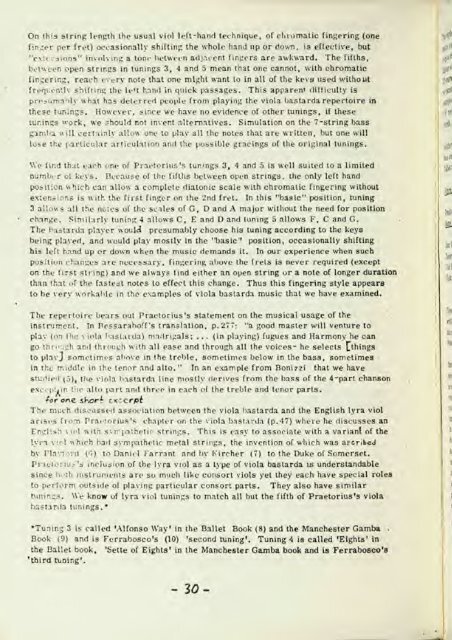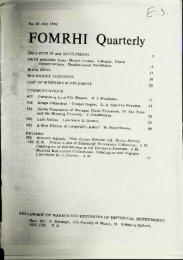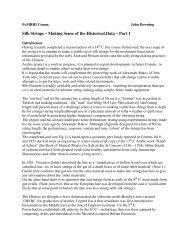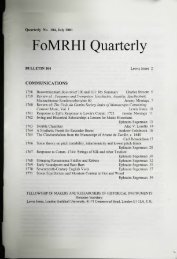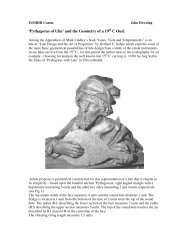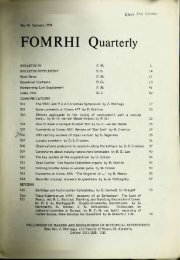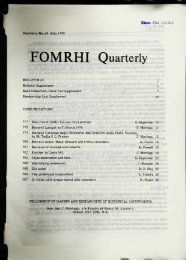•rf - FoMRHI
•rf - FoMRHI
•rf - FoMRHI
You also want an ePaper? Increase the reach of your titles
YUMPU automatically turns print PDFs into web optimized ePapers that Google loves.
On this string length the usuai viol left-hand technique, of chromatic fingering (one<br />
finger per fret) occasionally shifting the whole hand up or down, is effective, but<br />
"extersions" involving a tone between adjacent fingcrs are awkward. The fifths,<br />
between open strings in tunings 3, 4 and 5 mean that one cannot, with chromatic<br />
fingering, reach every note that one might want to in ali of the kevs used without<br />
frequenti'.- shifting the left hand in quick passages. This apparem difficulty is<br />
presumably what has deterrcd people from playing the viola bastarda repertoire in<br />
these tunings. However, since we have no evidence of other tunings, if these<br />
tunings work, we should not invent alternatives. Simulation on the 7-string bass<br />
gamba will certainly allow one to play ali the notes that are written, but one will<br />
lose the particular articulation and the possible gracings of the originai tunings.<br />
We find that each one of Praetorius's tunmgs 3, 4 and 5 is well suited to a limited<br />
number ot keys. Because of the fifths between open strings. the only left hand<br />
position which can allow a complete diatonic scale with chromatic fingering without<br />
extensions is with the first finger on the 2nd fret. In this "basic" position, tuning<br />
3 allows ali the notes of the scales of G, D and A major without the need for position<br />
change. Similarly tuning 4 allows C, E and D and tuning 5 allows F, C and G.<br />
The bastarda player would presumably choose his tuning according to the keys<br />
being played, and would play mostly in the "basic" position, occasionally shifting<br />
his left hand up or down when the music demands it. In our experience when such<br />
position changes are necessary, fingering above the frets is never required (except<br />
on the first string) and we always find either an open string or a note of longer duration<br />
than that of the fastest notes to effect this change. Thus this fingering style appears<br />
to be very workable in the examples of viola bastarda music that we have examined.<br />
The repertoire bears out Praetorius's statement on the musical usage of the<br />
instrument. In Bessaraboff *s translation, p.277: "a good master will venture to<br />
play (on the viola bastarda) madrigals; ... (in playing) fugues and Harmony he can<br />
go through and through with ali ease and through ali the voices- he selects [.things<br />
to plavj sometimes above in the treble, sometimes below in the bass, sometimes<br />
in the middle in the tenor and alto. " In an example from Bonizzi that we have<br />
studied (5), the viola bastarda line mostly derives from the bass of the 4-part chanson<br />
exccpt/in the alto part and three in each of the treble and tenor parts.<br />
for one. shorh excerpr<br />
The much diseussed association between the viola bastarda and the English lyra viol<br />
arises from Praetorius's chapter on the viola bastarda (p.47) where he discusses an<br />
English \ iol with sv :r pathetic strings. This is easy to associate with a variant of the<br />
lyra viol which had sympathetic metal strings, the invention of which was ascribed<br />
by Flayford (6) to Daniel Farrant and by Kircher (7) to the Duke of Somerset.<br />
Praetorius's inclusion of the lyra viol as a type of viola bastarda is understandable<br />
since both instruments are so much like consort viols yet they each have special roles<br />
to perform outside of playing particular consort parts. They also have similar<br />
tunings. We know of lyra viol tunings to match ali but the fifth of Praetorius's viola<br />
bastarda tunings. •<br />
•Tuning 3 is called 'Alfonso Way' in the Ballet Book (8) and the Manchester Gamba ;<br />
Book (9) and is Ferrabosco's (10) 'second tuning'. Tuning 4 is called 'Eights' in<br />
the Ballet book, 'Sette of Eights' in the Manchester Gamba book and is Ferrabosco's<br />
'third tuning'.<br />
- 30-


